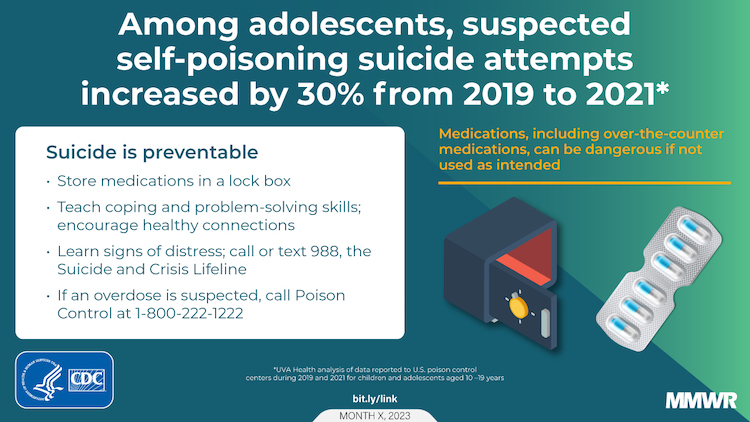COVID-19 Pandemic Saw Major Increase in Children and Adolescents Attempting Suicide by Poison, Study Finds
The rate of suspected suicide attempts by poisoning among children and adolescents ages 10-19 reported to U.S. poison centers increased 30% during 2021 – the COVID-19 pandemic’s first full year – compared with 2019, a new UVA Health study found.
 The rate of suspected suicide attempts by poisoning among children and adolescents ages 10-19 reported to U.S. poison centers increased 30% during 2021 – the COVID-19 pandemic’s first full year – compared with 2019, a new UVA Health study found.
The rate of suspected suicide attempts by poisoning among children and adolescents ages 10-19 reported to U.S. poison centers increased 30% during 2021 – the COVID-19 pandemic’s first full year – compared with 2019, a new UVA Health study found.
The rate of suspected suicide attempts by poisoning among children ages 10-12 increased 73% during 2021 compared with 2019. Among adolescents ages 13-15, the rate of suspected suicide attempts by poisoning increased 48.8% in 2021 versus 2019. The rate of suspected suicide attempts by poisoning among females ages 10-19 increased 36.8% in 2021 compared with 2019.
The findings are based on a review of cases reported to the National Poison Data System by U.S. poison centers as “intentional suspected suicide,” which encompass both suspected suicide attempts and intentional self-harm. Girls accounted for 81.2% of the suspected suicide attempts among adolescents ages 10-19 in 2021, compared with 77% in 2019. These increases in suspected suicides occurred while overall calls to the nation’s poison centers decreased 3.1% from 2019 to 2021.
The findings build on a concerning trend identified in an earlier UVA Health study, which found suspected suicide attempts by poisoning among children ages 6-19 increased 26.7% between 2015 and 2020.
“This significant increase in suicide attempts during the pandemic surprised us,” said Christopher Holstege, MD, medical director of the Blue Ridge Poison Center at UVA Health and chief of the Division of Medical Toxicology at the University of Virginia School of Medicine. “We are alarmed at the dramatic increase in suicide attempts in such a young population, which continues to escalate according to our data.”
The two most common substances involved in the reported suicide attempts were acetaminophen and ibuprofen, two commonly available, over-the-counter pain relievers. The other most used substances were two antidepressant medications – sertraline and fluoxetine – along with diphenhydramine, an antihistamine available over the counter that is frequently used to treat allergies.
“These findings suggest that the mental health of children and adolescents might still be affected by the pandemic, raising concerns about long-term consequences, especially given that previous attempted suicide has been found to be the strongest predictor of subsequent death by suicide,” the researchers write in a scientific paper outlining the findings.
Based on the data, the researchers recommend a comprehensive approach to suicide prevention through partnerships among families, teachers, mental health professionals and public health leaders. Given how frequently over-the-counter medications are used in suicide attempts, the researchers also suggest considering safety measures such as heightened public education initiatives on the safe storage of over-the-counter medications and the availability of assistance in case of an overdose through America’s poison centers by calling 800-222-1222. They also recommend additional promotion of the national 988 Suicide and Crisis Lifeline for people experiencing a mental health crisis.
“As a society, we need to come together in a multi-disciplinary manner and strategize on how to best mitigate this rapidly escalating threat to our youth,” Holstege said.
Last month, UVA Children’s and Sentara Martha Jefferson Hospital announced plans to create a new outpatient clinic in Albemarle County to meet the growing need for pediatric neurodevelopmental and behavioral health care in Central Virginia.
Publication: Rita Farah, et al., Suspected Suicide Attempts by Self-Poisoning Among Persons Aged 10–19 Years During the COVID-19 Pandemic — United States, 2020–2022, Morbidity and Mortality Weekly Report (2023). DOI: 10.15585/mmwr.mm7216a3.
Original Story Source: University of Virginia Health System

 Alerts Sign-up
Alerts Sign-up